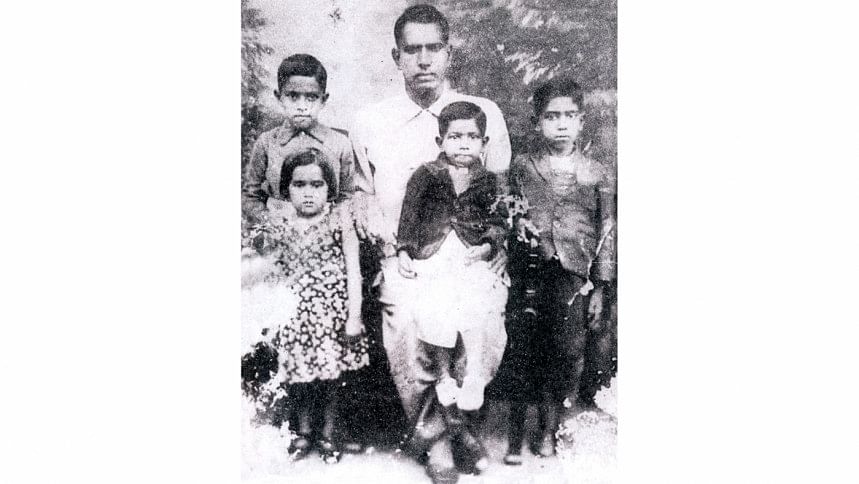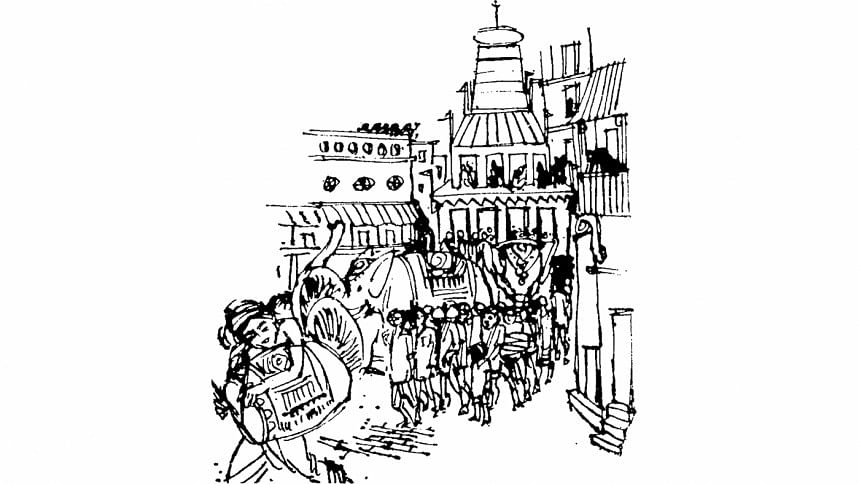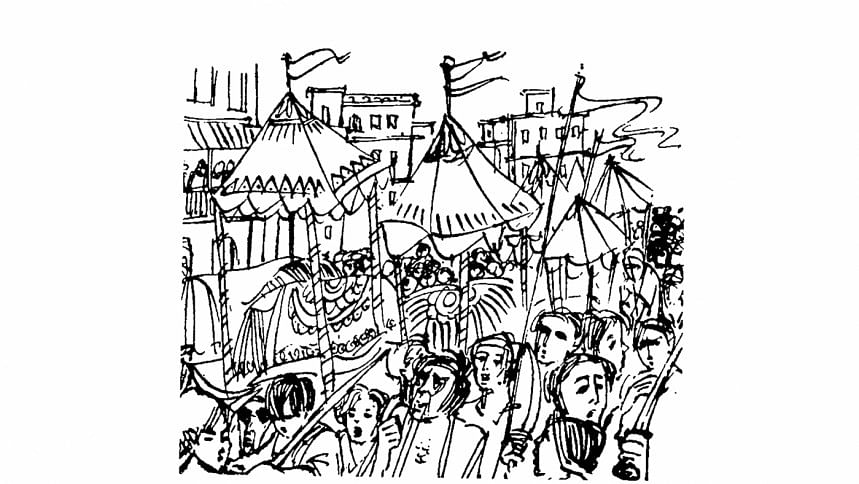The poetic tradition in the East, particularly in Greater India, has long been characterised by diverse literary experimentation, significantly influenced by Sanskritic, Arabic, and Persian cosmopolitan traditions. Over time, this tradition also drew substantial inspiration from various aspects of colonial modern aesthetics. Poet Shamsur Rahman—affectionately known as Bacchu among close friends—embodies this cosmopolitan narrative. To critically assess Shamsur Rahman's aesthetic sensibility and modernist tone, we must explore the various trajectories within the framework of multiple modernities.
It is also crucial to situate the poet's upbringing, the childhood scenarios depicted in his poetry and memoirs, and his concepts of self and city within the context of the Islamicate, as outlined by M.S. Hodgson. When referring to the Islamicate and Muslim Bengali childhood of old Dhaka, it should not be conflated with an Islamic one. The terms "Islamicate" and "Muslim Bengali" are secular and worldly, often linked to a social and cultural complex that is distinct from religiosity.
Shamsur Rahman developed a stylistic approach that diverged from the Calcutta-based concept of modernity and the European notion of cosmopolitanism. His poetic language was deeply influenced by his Islamicate Muslim childhood, which subtly informed the narrative of his work.
The Poetics of Islamicate Childhood
In the following poems, we will explore the social and psychological atmosphere of Shamsur Rahman's childhood. Among his poetry centred on childhood, he often evokes the multi-faceted, lost memories of his early years. However, our primary focus here is to unpack the cultural dimensions of Bengali Muslim childhood, its worldview, and its ethos. By delving into the poetics of Rahman's childhood and his autobiographical reflections, we gain insight into the upbringing of Bengali Muslims during the late colonial period. As previously indicated, we are making a clear distinction between the Islamic and the Islamicate; when we refer to Muslim Bengali childhood, it must be situated within the Islamicate sphere—undisputedly non-sectarian and all-encompassing, distinct from the religious dimension.

An unknown, oft-visited lamplighter with a ladder, usually found in the alleyways at dusk
The vivid portrayal of the lamplighter of old Dhaka in the early 1930s serves as a representative sample of the poet's early childhood. Through this narrative, Shamsur Rahman retrieves the lost heritage of earlier town planning and the daily life of old Dhaka's alleys. It is important to note that during that time, DESCO, WASA, and WAPDA were not parts of Dhaka's infrastructure, which does not mean that Dhaka had yet to develop into a modern city or become a hub for the bourgeoisie. From an urban studies perspective, Dhaka's lineage as a city can be traced back to the Middle Ages, if not earlier. As we explore Dhaka's contours through Shamsur's poetic narration, the distinctive features of an oriental and Mughal city like Dhaka will become evident.
The depiction of the lamplighter's tattered shirt and curly mustache reminds us of the often-marginal characters in the city, celebrated in surrealist discourse, who reveal the tales of the city. This is superbly portrayed in Shamsur's famous poem, Shoishober Bati-ola Amake (Chance encounter with that famed lamplighter of my old town childhood). In this regard, Shamsur's lamplighter, if not a connoisseur of the city, resembles Baudelaire's flâneur: both recapture the many lives of a decadent city. The arrival of the lamplighter at dusk, signalling the dazzling glow of night, is one of Shamsur's finest works, creating an iconic character easily identified by readers as the from 46 Mahut-Toli.
Ma is never found in the green room
This narrative captures the inner world of Bengali Muslim women in relation to the arts and aesthetics. Unlike their Hindu counterparts, the emergence of Bengali Muslim women in the public sphere took a different path. In his poems and autobiography, Shamsur Rahman reflects on growing up in an environment often devoid of arts and aesthetics, focusing instead on school textbooks, though this was not always the case. He poignantly reveals that he never saw his mother sing, prompting us to consider the predicament of Bengali Muslim women. Shamsur challenges us to confront the question of modernity for Bengali Muslims. This is evident in every line of his work. The poem Kokhono Amar Ma'ke (Ma is never found in the green room) is less concerned with aesthetic judgment and more with meditative reflection on the mother figure within a Freudian narrative, distinct from the typical Oedipus complex.
Manhood & its cracked mirror
In the poetic narration of Dussomoyer Mukhomukhi (Manhood reminisces and relives the lost childhood), Shamsur Rahman takes us back to his early childhood, growing up in a typical Bengali Muslim household. This poem vividly depicts the evolving milieu of Bengali Muslim childhood, serving as an archive of a young boy's coming-of-age story. The mosque, with its intricate floral engravings, decorations—a hallmark of Islamicate architecture from the Sultanate era—and the water tank with its fish, all captivated Shamsur. He also recalls his father reciting the Azan during a deadly cyclone to calm the approaching storm. These images not only recapture memories but also serve as a poetic archive of Bengali Muslim childhood, common across the social spectrum.

To become more Hindu among Hindus
The remembrance of things past is beautifully articulated in the esoteric poem Chelebela Theke (From My Childhood). It can be argued that this poem serves as a rare document of partition from a poetic perspective, documenting the secular and non-sectarian upbringing in old Dhaka. Among his friends, Shamsur names Arun, Sunil, Subimal, Surjokishor, Taher, and Ashraf. One fine morning, the poet discovers that all his Hindu classmates, including Subimal and Shisir, have left for India—a decision often attributed to the desire to become "more Hindu among Hindus"—a typical narrative of the 1947 partition. His Hindu playmates and non-sectarian Hindu teacher at Pogose School always compelled him, in later days, to reflect on the plight of Hindus in Bangladesh. Besides the tale of Hindu-Muslim solidarity and the tragedy of partition, Shamsur also recounts the heartbreaking loss of his sister, Nehar, in the poem. It was on this occasion that the poet wrote his first elegy, in memory of his deceased sister. All these events unfolded in the Islamicate old town, where Shamsur lived as a Muslim among Hindus.
One Fine Eid Morning
In the poem Das Takar Note Ebong Shoishob (One Fine Eid Morning), Shamsur Rahman reflects on his early childhood, again typical of a Bengali Muslim upbringing. While many poets have written about Durgapuja, Saraswati Puja, and Rathjatra, the world of Bengali Muslim childhood has rarely been explored. Shamsur Rahman ventures into this realm, offering a vivid representation of early Muslim childhood, centring around the Eid festival and the tradition of giving Eid money, known as edyee in the vernacular. He evokes memories of his childhood neighbourhood: the house of Henry, the lamplighter, kulphiwala, and the typical horse stable—a reminiscence of Muslim heritage—with the celebration of Eid at the heart of it.
The Soft Stretch of Father's Prayer-Mat
Shamsur Rahman wrote several poems about the liberation war of Bangladesh, with Swadhinota Tumi being the most renowned. In this poem, he creates a surreal image of his father's prayer mat. During his early childhood, Shamsur would often intrude on his father's prayer time, occasionally receiving a gentle scolding for his interruptions. Rather than merely evoking lost time, Shamsur Rahman draws us into a vivid reliving of it, seamlessly blending past and present.

The poetic memoire of Shahi Dhaka: the life of an oriental city
We often hear that poetry serves as a journal and a representation of the everyday. In Shamsur Rahman's work, certain figures and images repeatedly resurface: the Batiwala, Bhakarkhaniwala, Bhistiwala, and horse stable all hint at the city's longstanding Islamicate orientation. Alizan Beyapari, with his pump shoes and his renovation of the seventeenth-century Mirza Mosque—now known as Sitara Mosque, with its colourful, engraved star domes—captivated Shamsur. The poet also explores the worlds of Kawali, Merasin (marginalised women musicians), and the vernacular, including the unknown naive painter Noyeem Mia, with whom he delved into the enigmatic world of painting. Mr. Harney and his son Waisy, along with the neighbourhood populated by Anglo-Indians, Armenian traders, and their places of worship—including churches—feature prominently in his work. Lastly, Shamsur intertwines his persona with the grandeur of Shahi palaces and caravanserais like Choto Katra and Boro Katra. He also depicts the home and world of the Dhakai Nabab, highlighting the divide between them and the unlettered kutti, as well as the native Bengali Muslim. Landmarks in the old town, such as Bahadur Shah Zafar Park and Lalbagh Fort evoke memories of the persecution and execution of soldiers during the First War of Independence in 1857.
It is evident from his writing that his family and neighbourhood were deeply rooted in religiosity, though not in a sectarian way. As a child, Shamsur was influenced by both the Karbala and Hindu Vaisnavite traditions, such as Janmashtami. He fondly recalls the evocative memories associated with Dhakeswari and Ramna Temple and participated solemnly in various Pujo celebrations. This should be understood within the framework of a secular, non-sectarian, and Islamicate worldview. One of his most cherished memories relates to Karbala, which holds a central place in Bengali Muslim culture. Notably, he memorised Mir Mosarraf Hossain's Bishad Sindhu while reading it aloud to his grandmother during his early childhood. In several of his poems and some prose written in memoir form, Karbala, Tazia, the Duldul horse, and Hossaini Dalan are recalled with deep reverence.
His childhood memories serve as a wellspring of inspiration for the development of his unique poetic style. While it may initially appear that he is reliving a colonial and medieval city, it is clear that Shamsur's work must be understood within the broader context of the city's distinctive lineage within the global city narrative.
The many facets of fanciful and delirious Dhaka nights are vividly captured in his now-classic poem Ai Matuala Rait (The Delirious Dhaka Night), written after he returned from a tavern at midnight. The poem's distinctive style is apparent in its masterful use of local idioms and the Perso-Arabic vocabulary of the old town.
Through these images, Shamsur crafts the narrative of his poetry. His childhood memories serve as a wellspring of inspiration for the development of his unique poetic style. While it may initially appear that he is reliving a colonial and medieval city, it is clear that Shamsur's work must be understood within the broader context of the city's distinctive lineage within the global city narrative.
It is often said that Dhaka does not fit the Western concept of a city; rather, it resembles a series of souks, as noted by many anthropologists. The concept of a souk has a different genealogy in the Middle Eastern world, often carrying an Islamicate connotation. The trajectory of an oriental city is markedly different from that of a Western one. It is clear that the genealogy of an oriental city like Dhaka cannot be fully explained by the Western narrative; it must be understood within the framework of multiple, diverse, and alternative modernities. Many sociologists and anthropologists of urban life have emphasised the unique and distinctive character of our city within the global city narrative.
The Swadeshi modernity: the lineage of our modern poetics
Kavitar Songe Gerosthali (Living together with poetry) is one of Shamsur Rahman's most poignant poems. In this work, we find early signs of his poetic development. Through his creative imagination, Shamsur vividly illustrates his journey to becoming a poet. We also gain insight into his liberal upbringing, guided by his elder brother, who was deeply immersed in the world of Tagore. Shamsur's poetic perspective was influenced by a fortuitous encounter with Tagore's Chayanika, followed by his discovery of Sanchayita in the early 1940s. By the early 1950s, he was drawn to the modernist poets of the 1930s, notably Das, Bose, and Dutt. He also found inspiration in Western modernist and surrealist poets such as Paul Éluard and Louis Aragon. William Radice aptly notes that while Shamsur could craft a perfect sonnet, he preferred a poetic form that allowed freedom and flexibility, yet never appeared uncontrolled.
Although this poem does not explicitly detail his poetic influences, Shamsur elsewhere acknowledges various poets from different traditions, including Islamicate figures like Ghalib, Hafiz, and Rumi, as well as other renowned Persian and cosmopolitan poets. It is noteworthy that, early in his career, he introduced the Multani poet Khwaja Farid to his audience.
In 1953, Shamsur delivered a lecture at Shantiniketan, where he clearly differentiated between Islamic revivalist poetry and the secular, Islamicate tradition. The former included poets like Golam Mustafa and Farrukh Ahmad, while the latter comprised poets such as Ahsan Habib and others. Shamsur was committed to advancing the secular tradition. In developing his own style, he regularly drew inspiration from Hafiz, Ghalib, and Neruda, deeply immersing himself in his childhood memories. He frequently highlighted that his early years were enriched by the poetry and epics of Islamic, Persian, and Sanskrit cosmopolitan discourses, all of which shaped the contours of his poetic style.
As we often say, Shamsur Rahman, or Bacchu, was the quintessential poet of Dhaka. He vividly portrayed the everyday life of Bangladesh and captured the political events of the century through his poetic vision. In doing so, he developed a stylistic approach that diverged from the Calcutta-based concept of modernity and the European notion of cosmopolitanism. His poetic language was deeply influenced by his Islamicate Muslim childhood, which subtly informed the narrative of his work.
The lineage of Shamsur's poetics, both within his poetry and in the context of Dhaka, should not be framed within the parameters of Western modernity. As it is often said, modernity is not singular but plural, encompassing numerous distinct styles. Ultimately, Shamsur Rahman, our Bacchu, represents the essence of Swadeshi modernity—a modernity shaped by our own unique narrative of disenchantment and reflected in the poetics of our world.
Mujib Rahman is a journalist at The Daily Star and also teaches at East West University


Comments